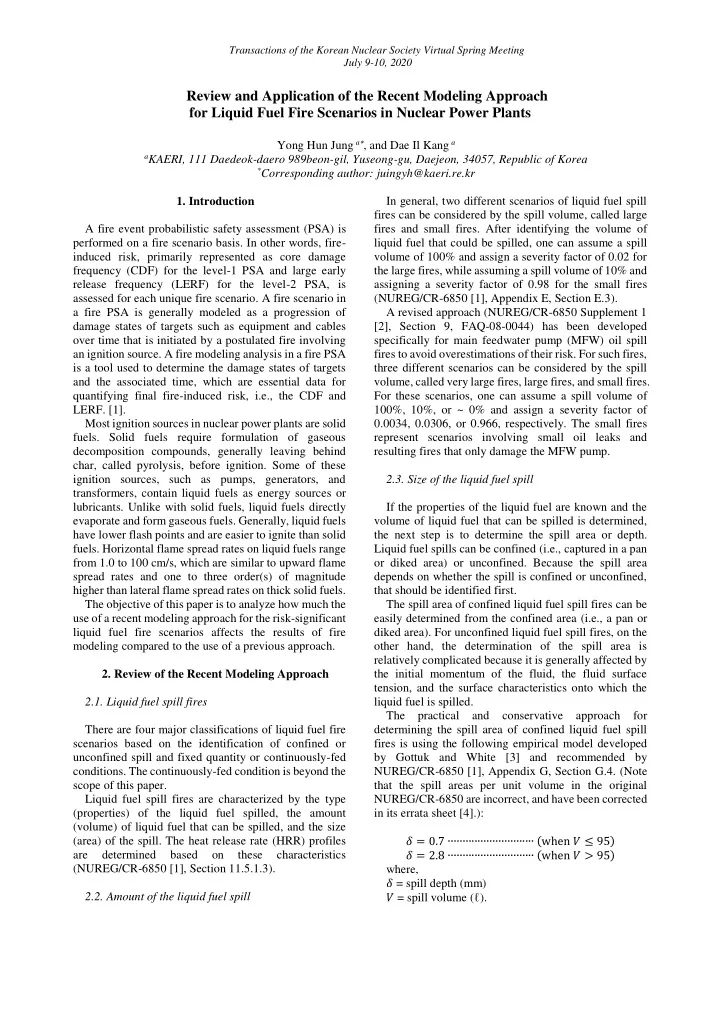

Transactions of the Korean Nuclear Society Virtual Spring Meeting July 9-10, 2020 Review and Application of the Recent Modeling Approach for Liquid Fuel Fire Scenarios in Nuclear Power Plants Yong Hun Jung a , and Dae Il Kang a a KAERI, 111 Daedeok-daero 989beon-gil, Yuseong-gu, Daejeon, 34057, Republic of Korea * Corresponding author: juingyh@kaeri.re.kr 1. Introduction In general, two different scenarios of liquid fuel spill fires can be considered by the spill volume, called large A fire event probabilistic safety assessment (PSA) is fires and small fires. After identifying the volume of performed on a fire scenario basis. In other words, fire- liquid fuel that could be spilled, one can assume a spill induced risk, primarily represented as core damage volume of 100% and assign a severity factor of 0.02 for frequency (CDF) for the level-1 PSA and large early the large fires, while assuming a spill volume of 10% and release frequency (LERF) for the level-2 PSA, is assigning a severity factor of 0.98 for the small fires assessed for each unique fire scenario. A fire scenario in (NUREG/CR-6850 [1], Appendix E, Section E.3). a fire PSA is generally modeled as a progression of A revised approach (NUREG/CR-6850 Supplement 1 damage states of targets such as equipment and cables [2], Section 9, FAQ-08-0044) has been developed over time that is initiated by a postulated fire involving specifically for main feedwater pump (MFW) oil spill an ignition source. A fire modeling analysis in a fire PSA fires to avoid overestimations of their risk. For such fires, is a tool used to determine the damage states of targets three different scenarios can be considered by the spill and the associated time, which are essential data for volume, called very large fires, large fires, and small fires. quantifying final fire-induced risk, i.e., the CDF and For these scenarios, one can assume a spill volume of LERF. [1]. 100%, 10%, or ~ 0% and assign a severity factor of Most ignition sources in nuclear power plants are solid 0.0034, 0.0306, or 0.966, respectively. The small fires fuels. Solid fuels require formulation of gaseous represent scenarios involving small oil leaks and decomposition compounds, generally leaving behind resulting fires that only damage the MFW pump. char, called pyrolysis, before ignition. Some of these ignition sources, such as pumps, generators, and 2.3. Size of the liquid fuel spill transformers, contain liquid fuels as energy sources or lubricants. Unlike with solid fuels, liquid fuels directly If the properties of the liquid fuel are known and the evaporate and form gaseous fuels. Generally, liquid fuels volume of liquid fuel that can be spilled is determined, have lower flash points and are easier to ignite than solid the next step is to determine the spill area or depth. fuels. Horizontal flame spread rates on liquid fuels range Liquid fuel spills can be confined (i.e., captured in a pan from 1.0 to 100 cm/s, which are similar to upward flame or diked area) or unconfined. Because the spill area spread rates and one to three order(s) of magnitude depends on whether the spill is confined or unconfined, higher than lateral flame spread rates on thick solid fuels. that should be identified first. The objective of this paper is to analyze how much the The spill area of confined liquid fuel spill fires can be use of a recent modeling approach for the risk-significant easily determined from the confined area (i.e., a pan or liquid fuel fire scenarios affects the results of fire diked area). For unconfined liquid fuel spill fires, on the modeling compared to the use of a previous approach. other hand, the determination of the spill area is relatively complicated because it is generally affected by 2. Review of the Recent Modeling Approach the initial momentum of the fluid, the fluid surface tension, and the surface characteristics onto which the 2.1. Liquid fuel spill fires liquid fuel is spilled. The practical and conservative approach for There are four major classifications of liquid fuel fire determining the spill area of confined liquid fuel spill scenarios based on the identification of confined or fires is using the following empirical model developed unconfined spill and fixed quantity or continuously-fed by Gottuk and White [3] and recommended by conditions. The continuously-fed condition is beyond the NUREG/CR-6850 [1], Appendix G, Section G.4. (Note scope of this paper. that the spill areas per unit volume in the original Liquid fuel spill fires are characterized by the type NUREG/CR-6850 are incorrect, and have been corrected (properties) of the liquid fuel spilled, the amount in its errata sheet [4].): (volume) of liquid fuel that can be spilled, and the size 𝜀 = 0.7 ∙∙∙∙∙∙∙∙∙∙∙∙∙∙∙∙∙∙∙∙∙∙∙∙∙∙∙∙∙ (when 𝑊 ≤ 95) (area) of the spill. The heat release rate (HRR) profiles are determined based on these characteristics 𝜀 = 2.8 ∙∙∙∙∙∙∙∙∙∙∙∙∙∙∙∙∙∙∙∙∙∙∙∙∙∙∙∙∙ (when 𝑊 > 95) (NUREG/CR-6850 [1], Section 11.5.1.3). where, 𝜀 = spill depth (mm) 𝑊 = spill volume ( ℓ ). 2.2. Amount of the liquid fuel spill
Recommend
More recommend